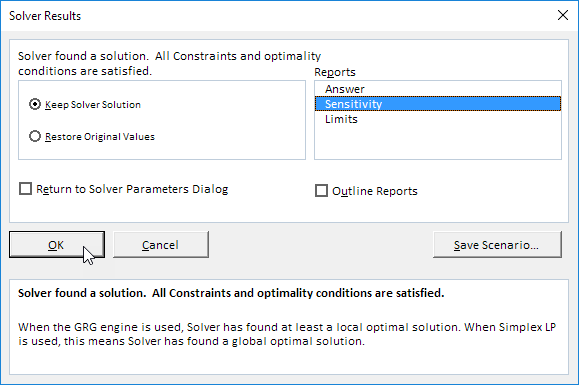It is used for performing sensitivity analysis in Excel or some other solution. Learn with video instruction in CFI’s Advanced Excel Course. Step 3: Use the Ribbon to Launch Excel Solver. The Excel Solver function is located on the Data Ribbon and the keyboard shortcut on Windows is Alt, A, Y21. – If you get prompted that Solver is not currently installed, click Yes to install it. 4. After you load Solver, the Solver command is available in the “Analysis group” on the “Data” tab – MAC users. 1. Open Excel for Mac 2011 and begin by clicking on the “Tools” menu. 2. Solver generates a different sensitivity report for nonlinear problems, as shown in Figure 13-17. These reports tell you how sensitive the solution is to small changes in variables and constraints. In the Add-Ins available box, select the Solver Add-In check box, and then click OK. If Solver Add-in is not listed in the Add-Ins available box, click Browse to locate the add-in. If you get a prompt that the Solver add-in is not currently installed on your computer, click Yes in the dialog box to install it. After you load the Solver add-in, the Solver button is available on the Data tab.

The Sensitivity Report provides classical sensitivity analysis information for both linear and nonlinear programming problems. It is available for models that do not contain any integer or binary constraints (which we will learn about later in this course). In this module we will focus on the Sensitivity Report for linear models.
Solver generates a different sensitivity report for nonlinear problems, as shown in Figure 13-17. These reports tell you how sensitive the solution is to small changes in variables and constraints.
An example of a Sensitivity Report generated for a simple Product Mix example is shown below.
Interpreting Reduced Costs and Shadow Prices
Reduced Costs are the most basic form of sensitivity analysis information. The reduced cost for a variable is nonzero only when the variable’s value is equal to its upper or lower bound at the optimal solution. In this example problem, all variables have a lower bound of zero (i.e. a non-negativity constraint) and no upper bound. Moving the variable’s value away from the bound (or tightening the bound) will worsen the objective function’s value; conversely, “loosening” the bound will improve the objective. The reduced cost measures the change in the objective function’s value per unit increase in the variable’s value. In the example Sensitivity Report above, the dual value for producing speakers is -2.5, meaning that if we were to tighten the lower bound on speakers (move it from 0 to 1), our total profit would decrease by $2.50.

The Shadow Price for a constraint is nonzero only when the constraint is equal to its bound. This is called a binding constraint, and its value was driven to the bound during the optimization process. “Tightening” a binding constraint (making it more strict) will worsen the objective function’s value; conversely, loosening a binding constraint will improve the objective. The Shadow Price measures the change in the objective function’s value per unit increase in the constraint’s bound. In the example report above, increasing the number of electronics units from 600 to 601 will allow the Solver to increase total profit by $25.
Solver Add In Excel Mac

Excel Solver Sensitivity Report Missing
The Allowable Increase and Allowable Decrease fields in the report show the range of increases and decreases for which the Reduced Costs and Shadow Prices remain constant.